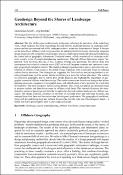Options
Geodesign Beyond the Shores of Landscape Architecture
Author(s)
Date Issued
2024-06
Date Available
2025-02-28T12:42:12Z
Abstract
The title of this paper is deliberately ambiguous, reflecting the intentions of the underlying work, which examines the field of geodesign beyond both the traditional practice of landscape architecture and the conventional role of the landscape architect as the sole determinant of design. It focuses on the data-driven offshore wind energy potential in maritime Northern Europe. Geodesign integrates design proposals with simulations of geographic impacts, challenging traditional roles and emphasizing the central role of geographic information. Territorial waters, widely overlooked by landscape archi-tects, reveal a series of complicated planning mechanisms. Although offshore landscapes appear “un-planned” from the shore, they are, in fact, evidence of large-scale geodesign. The chosen study area encompasses the exclusive economic zones (EEZ) of several European countries and represents a com-plex geopolitical and spatial context. The related geodesign experimentation aims to maximize the contribution of offshore wind energy to the global energy transition, with a particular focus on reducing carbon dioxide emissions. Two strategies are suggested: the first involves maximizing turbines in existing planned areas, and the second entails identifying new areas for turbine placement. The authors use extensive geographic data to inform their design decisions and highlight the importance of geographic context in offshore wind farm design. The results demonstrate data-driven designs that inform planning processes, expansion of designated areas, and identification of new locations for wind farm development. The study integrates factors such as altitude, wind speed, navigation, and protected areas to propose realistic and data-driven areas for offshore wind farms. This research illustrates the trans-formative power of geodesign and extends its application beyond onshore landscapes to offshore sea-scapes. The design outcome, presented in the form of projected areas and individual locations, has emerged from hard facts and data rather than the designer's preferences. The geographical conditions, along with the underlying legal and political frameworks, take the helm out of the designer's hands – a reality that future geodesigners must acknowledge and accept.
Type of Material
Journal Article
Publisher
Wichmann Verlag
Journal
Journal of Digital Landscape Architecture
Volume
2024
Issue
9
Start Page
394
End Page
404
Copyright (Published Version)
2024 Wichmann Verlag
Language
English
Status of Item
Peer reviewed
ISSN
2367-4253
This item is made available under a Creative Commons License
File(s)
Loading...
Name
Paper Schob Rekittke 2024 537752036.pdf
Size
4.11 MB
Format
Adobe PDF
Checksum (MD5)
468e2abbca31337e1260c72167467345
Owning collection